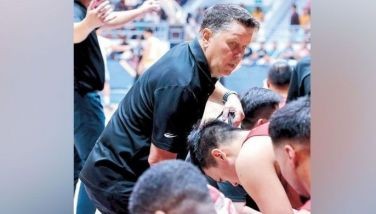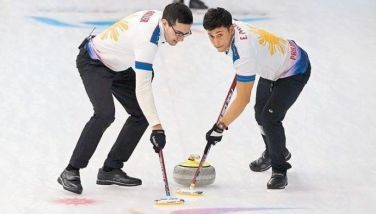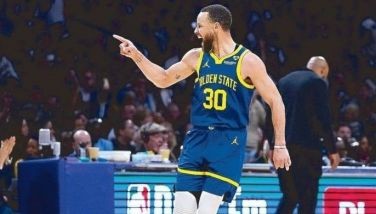Players for export
July 8, 2002 | 12:00am
The entry of China’s Yao Ming as the top draft pick of the National Basketball Association signals a significant change in the way basketball is being viewed around the globe. No player bred outside the United States, and with no American college basketball experience, had ever been made the top recruit before.
There have, of course, been other foreign-born players who made waves in the world’s premier basketball league. The Los Angeles Lakers’ Kobe Bryant is considered somewhat of an international citizen who speaks three different languages. Patrick Ewing was born outside US shores, Hakeem Olajuwon, likewise. Germany’s Detlef Schrempf opened the door for European players. The late, lamented Drazen Petrovic perhaps underscored the impact they would have on the game with his prolific production before dying in a car crash on the autobahn after watching a World Men’s Championship game. But all of them had been molded by the US NCAA system. Not Yao Ming.
What does this mean? Several things come to mind, all good for the international game.
Size. Note that Yao and his teammates, Dallas Maverick Wang Zhizhi and Denver Nugget Menk Bateer, are all seven feet or taller. There is a maxim: you can’t teach height. But these three Asians have proven that height is a prime commodity that American professional teams are willing to pay top dollar for. And it doesn’t matter where they come from. What matters is how big they are.
Accomplishment. The three players mentioned, and many international players in the NBA, have all played in their continents’ top tournaments, commercial and amateur. China has dominated Asia for close to two decades, and is perennially the region’s representative to the Olympic Games. Yugoslavia and its neighboring countries have produced world-class teams in the last fifteen years. Australia has placed in the Olympics. All these countries’ players have made it to the NBA.
Discipline. Many American players come from colleges that have different systems, and several of them were stars on their college teams. They expect royal treatment, and end up as royal pains in the NBA. However, many European or Asian players come from highly regimented systems where structure, not stardom, is the emphasis. In other words, they take instruction well, and don’t have many bad habits. Yet. And many of them are the trailblazers for their countries, so they work harder at making a good impression.
Versatility. In continental competitions, players often play one position for one team and another for the national squad. This ability to shift from one role to another is a prime commodity in the pros. Many college centers, for example, have trouble shifting to power forward when they turn pro. For players who have been on many national teams, that isn’t a problem, since they are used to changing roles depending on the coach’s demands.
Offensive potential. One thing that has become obvious in the last decade and a half is the gradual decline in offense in the NBA. There are many factors, but one of them is lack of fundamentals and a playground style. Free throw shooting and field goal shooting have been dropping, and that has prompted the NBA to change even its defensive rules. However, with the influx of foreign-bred players, scoring is expected to climb back up to more acceptable levels.
Star power. Talk about Shaquille O’Neal. There is nobody on American shores who can stop him. But visions of foreign invaders like Yao Ming eventually coming up to Shaq standards fill the fantasies of many general managers. They will stop at nothing to find another franchise player, be it another Shaq or Air Jordan, whatever race he may be.
Marketing clout. Like it or not, the NBA has almost saturated its market within the continental USA. Therefore, the lure of foreign players is two-fold. Imagine a platoon of Chinese behemoths selling merchandise to their two billion countrymen. Or how about Indonesian players pitching to over 200 million compatriots worldwide? This is undoubtedly the biggest untapped area of growth for the NBA, and it’s worth billions of dollars for them to tap into it now.
Catching up. In some ways, the NBA players may have relaxed. Note that teams playing against the various incarnations of the Dream Team have slowly trimmed the differences in scores with their idols. Slowly, American pros will realize that they have to step it up even more to put some more distance between them and the rest of the world. The competition from foreign players getting the same coaching will definitely spur them to improve their game even more. There are no more secrets.
What would be important for us to realize is that the Chinese have opened the NBA door for the rest of Asia. How soon can we jump in?
It only takes one.
There have, of course, been other foreign-born players who made waves in the world’s premier basketball league. The Los Angeles Lakers’ Kobe Bryant is considered somewhat of an international citizen who speaks three different languages. Patrick Ewing was born outside US shores, Hakeem Olajuwon, likewise. Germany’s Detlef Schrempf opened the door for European players. The late, lamented Drazen Petrovic perhaps underscored the impact they would have on the game with his prolific production before dying in a car crash on the autobahn after watching a World Men’s Championship game. But all of them had been molded by the US NCAA system. Not Yao Ming.
What does this mean? Several things come to mind, all good for the international game.
Size. Note that Yao and his teammates, Dallas Maverick Wang Zhizhi and Denver Nugget Menk Bateer, are all seven feet or taller. There is a maxim: you can’t teach height. But these three Asians have proven that height is a prime commodity that American professional teams are willing to pay top dollar for. And it doesn’t matter where they come from. What matters is how big they are.
Accomplishment. The three players mentioned, and many international players in the NBA, have all played in their continents’ top tournaments, commercial and amateur. China has dominated Asia for close to two decades, and is perennially the region’s representative to the Olympic Games. Yugoslavia and its neighboring countries have produced world-class teams in the last fifteen years. Australia has placed in the Olympics. All these countries’ players have made it to the NBA.
Discipline. Many American players come from colleges that have different systems, and several of them were stars on their college teams. They expect royal treatment, and end up as royal pains in the NBA. However, many European or Asian players come from highly regimented systems where structure, not stardom, is the emphasis. In other words, they take instruction well, and don’t have many bad habits. Yet. And many of them are the trailblazers for their countries, so they work harder at making a good impression.
Versatility. In continental competitions, players often play one position for one team and another for the national squad. This ability to shift from one role to another is a prime commodity in the pros. Many college centers, for example, have trouble shifting to power forward when they turn pro. For players who have been on many national teams, that isn’t a problem, since they are used to changing roles depending on the coach’s demands.
Offensive potential. One thing that has become obvious in the last decade and a half is the gradual decline in offense in the NBA. There are many factors, but one of them is lack of fundamentals and a playground style. Free throw shooting and field goal shooting have been dropping, and that has prompted the NBA to change even its defensive rules. However, with the influx of foreign-bred players, scoring is expected to climb back up to more acceptable levels.
Star power. Talk about Shaquille O’Neal. There is nobody on American shores who can stop him. But visions of foreign invaders like Yao Ming eventually coming up to Shaq standards fill the fantasies of many general managers. They will stop at nothing to find another franchise player, be it another Shaq or Air Jordan, whatever race he may be.
Marketing clout. Like it or not, the NBA has almost saturated its market within the continental USA. Therefore, the lure of foreign players is two-fold. Imagine a platoon of Chinese behemoths selling merchandise to their two billion countrymen. Or how about Indonesian players pitching to over 200 million compatriots worldwide? This is undoubtedly the biggest untapped area of growth for the NBA, and it’s worth billions of dollars for them to tap into it now.
Catching up. In some ways, the NBA players may have relaxed. Note that teams playing against the various incarnations of the Dream Team have slowly trimmed the differences in scores with their idols. Slowly, American pros will realize that they have to step it up even more to put some more distance between them and the rest of the world. The competition from foreign players getting the same coaching will definitely spur them to improve their game even more. There are no more secrets.
What would be important for us to realize is that the Chinese have opened the NBA door for the rest of Asia. How soon can we jump in?
It only takes one.
BrandSpace Articles
<
>
- Latest
- Trending
Trending
Latest
Trending
Latest
Recommended



























